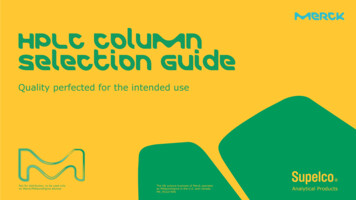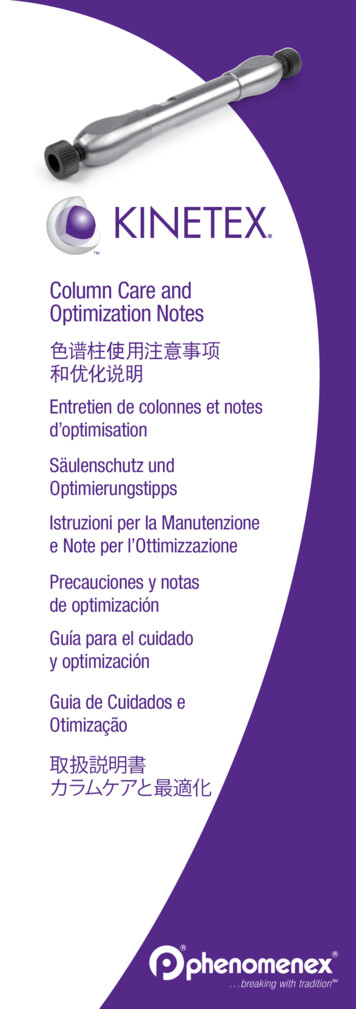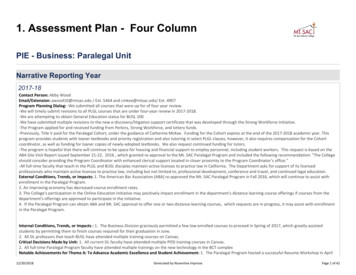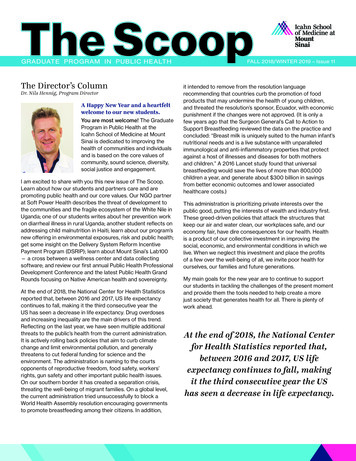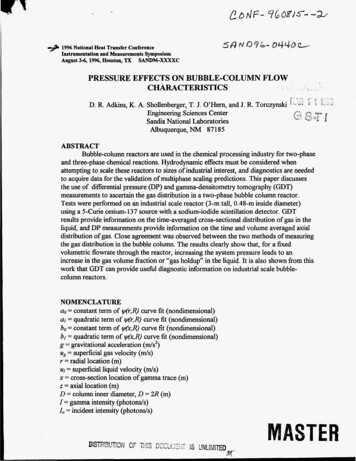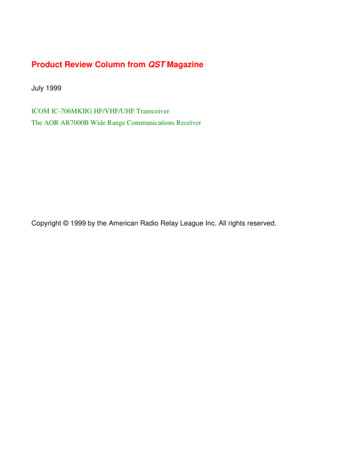
Transcription
Product Review Column from QST MagazineJuly 1999ICOM IC-706MKIIG HF/VHF/UHF TransceiverThe AOR AR7000B Wide Range Communications ReceiverCopyright 1999 by the American Radio Relay League Inc. All rights reserved.
Product ReviewEdited by Joe Bottiglieri, AA1GW Assistant Technical EditorICOM IC-706MKIIG HF/VHF/UHF TransceiverBy Rick Lindquist, N1RLSenior News EditorRecently I was scanning the automobileads—a vain exercise in wishful thinking—when I spotted a writeup for the latest modelof my current vehicle. Some of the featuresof the 1999 model were exactly the ones I’doften wished my car possessed. My vehiclewas the first of its line, however.This got me thinking about the time Ibought my first 2-meter all-mode transceiverback when I was active on the satellites. Itwas a fine little transceiver, and I only recently parted company with it. But I neverquite got over the fact that not six monthsafter I’d bought my latest and greatest radio,the manufacturer came out with a new andimproved version that incorporated all thefeatures I’d come to wish that my rig had.By now it should come as no surprise thatI own an “original” IC-706 transceiver. We“original” owners have become greener withenvy with each incarnation of the IC-706line. Some have happily “traded up.” Sincethe “original” debuted in 1995 to the oohsand aahs of the Amateur Radio community,ICOM has continued to up the ante (but notthe price) almost each succeeding year, almost like model years in the auto industry.But while the Amateur Radio industry is notlike the auto industry, ICOM has distinguished itself in recent years by trumping itsown aces and by correcting in subsequentmodels shortcomings that we have revealedduring the course of our product reviews.Getting yet another look at this hugelypopular model gave us the opportunity to diga bit more deeply into the basic unit, andto see how the various enhancements overthe subsequent two models have made theIC-706 a better radio.So, it is trade-in time again? Let’s seewhat the IC-706MKIIG brings to the table.What’s New, Pussycat?The primary new features of the MKIIGare the addition of the 70-cm band, the inclusion of DSP, and more power—50 W—on2 meters (history buffs will recall the original’706 put out 10 W on 2, the MKII 20 W). Yes,there are some other features that some userswill consider significant or important, but formost folks, these are the big three. We’ll getto the others in due course. They are largelyincremental improvements, however.DSP was an approximately 150 optionin the initial MKII. Now, it’s standard. Iffor nothing other than competitive reasons,this was a wise move on ICOM’s part. Werecently praised the Yaesu FT-100 for having superb DSP features—including theability to digitally tailor your transmitaudio on SSB—something you won’t findon the MKIIG. The DSP features on theIC-706MKIIG are not quite as rich, but theyare competent as far as they go.The DSP menu offers two primary features: noise reduction and an autonotchfilter to zap heterodynes while operatingSSB. The IC-706MKIIG lets you adjust thelevel of noise reduction you prefer. Whileoverall noise reduction was measured in thevicinity of 10 dB, as with the FT-100 wefound a bit of rolloff at the high end plus asubstantial amount of frequency ripple.With the NR cranked up full tilt boogie onSSB, the digital processing noise becomesmuch more apparent—even annoying attimes. But, it might very well be far lessBottom LineWith the addition of yet anotherband (70 cm), more power on 2 metersand the incremental improvementsmade with each new version of thispopular transceiver, perhaps the ’706has reached its zenith. There’s notmuch left to improve.annoying than the noise you’re trying toreduce, so it’s one of those trade-offs.One characteristic where the DSP in the’706 excels is the autonotch. Lab measurements revealed a notch depth for a single toneat greater than 50 dB. This is considerably better than the 20 dB notch depth on the FT-100.Something new for FM-lovers: TheMKIIG lets you set the “automatic” splitsfor repeater operation for HF, 50, 144 and430 MHz, a real plus for repeater users. Thesesettings are part of the initial set mode menu.This split is the one you’ll get when youpress the DUP button in FM mode. TheIC-706MKIIG “knows” the split directiontoo, depending upon the band segment.The MKIIG also includes tone scan capability—something that’s optional in the nearest competitor, the FT-100. The InstructionManual is a little unclear about this, but youhave to be in repeater mode and have TONenabled.The SWR Graph mode is a new and potentially useful feature that generates a littlegraphic representation of your SWR over aselectable range of HF or 6-meter frequencies. The menu lets you set the number ofsample points to graph (3, 5, 7 or 9) and thestep size between each point (10, 50, 100 or500 kHz). The resulting “graph” is a set ofvertical bars. The number of bars correFrom July 199 QST ARRL
Table 1ICOM IC-706MKIIG, serial number 01674Manufacturer’s Claimed SpecificationsFrequency coverage: Receive, 0.03-200, 400-470 MHz;transmit, 1.8-2, 3.5-4, 7-7.3, 10.1-10.15, 14-14.35,18.068-18.168, 21-21.45, 24.89-24.99, 28-29.7,50-54, 144-148, 430-450 MHz.Power requirement: Receive, 2.0 A; transmit, 20 A.Modes of operation: SSB, CW, AM, FM, AFSK, WFM(WFM receive only).Measured in the ARRL LabReceive, as specified; transmit 1.8-2, 3.5-4.1, 6.9-7.5, 9.9-10.5,13.9-14.5, 17.9-18.5, 20.9-21.5, 24.4-25.1, 28-30, 50-54,144-148, 430-450 MHz.Receive, 1.4 A; transmit, 21 A. Tested at 13.8 V.As specified.ReceiverSSB/CW sensitivity, bandwidth not specified,10 dB S/N: 1.8-30 MHz, 0.15 µV; 50-54 MHz, 0.12 µV; 144-148, 430-450 MHz, 0.11 µV.Receiver Dynamic TestingNoise floor (mds), 500-Hz filter:Preamp offPreamp on1.0 MHz–124 dBm–130 dBm3.5 MHz–137 dBm–142 dBm14 MHz–136 dBm–142 dBm50 MHz–139 dBm–142 dBm144 MHz–138 dBm–142 dBm432 MHz–138 dBm–143 dBm10 dB (S N)/N, 1-kHz tone, 30% modulation:Preamp offPreamp on1.0 MHz3.3 µV1.7 µV3.8 MHz0.68 µV0.44 µV50 MHz0.25 µV0.21 µV120 MHz0.91 µV0.39 µV144 MHz0.68 µV0.39 µV432 MHz0.67 µV0.37 µVFor 12 dB SINAD:Preamp offPreamp on29 MHz0.39 µV0.20 µV52 MHz0.25 µV0.17 µV146 MHz0.29 µV0.16 µV440 MHz0.29 µV0.16 µVBlocking dynamic range, 500-Hz filter:Preamp offPreamp on3.5 MHz125 dB118 dB14 MHz122 dB*120 dB*50 MHz116 dB*112 dB*144 MHz111 dB*101 dB*432 MHz109 dB*106 dB*Two-tone, third-order IMD dynamic range, 500-Hz filter:Preamp offPreamp on3.5 MHz89 dB87 dB14 MHz89 dB86 dB50 MHz89 dB82 dB144 MHz88 dB*83 dB432 MHz85 dB82 dBPreamp offPreamp on3.5 MHz–3.4 dBm–13 dBm14 MHz–1.3 dBm–11 dBm50 MHz–4.9 dBm–15 dBm144 MHz–3.0 dBm–16 dBm432 MHz–8.7 dBm–18 dBmPreamp off, 36.4 dBm; preamp on, 38.5 dBm.AM sensitivity, 10 dB S/N: 0.3-1.8 MHz, 13 µV;1.8-30 MHz, 2 µV; 50-54,144-148, 430-450 MHz, 1 µV.FM sensitivity, 12 dB SINAD: 28-30 MHz, 0.5 µV;50-54 MHz, 0.25 µV; 144-148, 430-450 MHz, 0.18 µV.Blocking dynamic range: Not specified.Two-tone, third-order IMD dynamic range: Not specified.Third-order intercept: Not specified.Second-order intercept: Not specified.00Reference Level: 0 dB PEPReference Level: 0 dB 24Frequency Offset (kHz)6810Figure 1—Worst-case HF spectral displayof the IC-706MKIIG transmitter during twotone intermodulation distortion (IMD)testing. The worst-case third-order productis approximately 30 dB below PEP output,and the worst-case fifth-order product isdown approximately 33 dB. Thetransceiver was being operated at 100 WPEP output at 21.25 MHz.From July 199 QST ARRL–80–10–8–6–4–2024Frequency Offset (kHz)6810Figure 2—Worst-case VHF/UHF spectraldisplay of the IC-706MKIIG transmitterduring two-tone intermodulation distortion(IMD) testing. The worst-case third-orderproduct is approximately 25 dB below PEPoutput, and the worst-case fifth-orderproduct is down approximately 40 dB. Thetransceiver was being operated at 50 WPEP output at 144.2 MHz.Figure 3—CW keying waveform for theIC-706MKIIG showing the first two dits in fullbreak-in (QSK) mode using external keying.Equivalent keying speed is approximately60 wpm. The upper trace is the actual keyclosure; the lower trace is the RF envelope.Horizontal divisions are 10 ms. The transceiverwas being operated at 100 W output at 14.2 MHz.Note the considerable shortening of both dits.
Manufacturer’s Claimed SpecificationsMeasured in the ARRL LabFM adjacent channel rejection: Not specified.20 kHz channel spacing, preamp on: 29 MHz, 66 dB; 52 MHz,64 dB; 146 MHz, 70 dB; 440 MHz, 71 dB.20 kHz channel spacing, preamp on: 29 MHz, 66 dB*; 52 MHz,64 dB*; 146 MHz, 70 dB*; 440 MHz, 75 dB; 10 MHz channelspacing, preamp on: 52 MHz, 91 dB; 146 MHz, 78 dB;440 MHz, 80 dB.S9 signal at 14.2 MHz: preamp off, 34 µV; preamp on, 11 µV;52 MHz, preamp off, 14 µV; preamp on, 6.6 µV; 146 MHz,preamp off, 18 µV, preamp on, 4.1 µV; 432 MHz,preamp off, 17 µV, preamp on, 5.7 µV.At threshold, preamp on: SSB, 14 MHz, 1.4 µV; FM, 29 MHz, 0.11 µV;52 MHz, 0.06 µV; 146 MHz, 0.06 µV; 440 MHz, 0.06 µV.2.1 W at 10% THD into 8 Ω.Range at -6dB points, (bandwidth):CW-N (500 Hz filter): 200-1000 Hz (800 Hz);CW-W: 182-3077 Hz (2895 Hz); USB-W: 182-3077 Hz (2895 Hz);LSB-W: 182-2667 Hz (2485 Hz); AM: 275-2860 Hz (2585 Hz).First IF rejection, 14 MHz, 120 dB; 50 MHz, 54 dB; 144 MHz, 64 dB;432 MHz, 108 dB; image rejection,14 MHz, 112 dB; 50 MHz, 121 dB;144 MHz, 71 dB; 432 MHz, 80 dB.FM two-tone, third-order IMD dynamic range: Not specified.S-meter sensitivity: Not specified.Squelch sensitivity: SSB, 5.6 µV; FM, 0.3 µV.Receiver audio output: 2.0 W at 10% THD into 8 Ω.IF/audio response: Not specified.Spurious and image rejection: 1.8-30 MHz, 70 dB;50-54 MHz, image rejection, 65 dB, IF rejection unspecified;144-148, 430-450 MHz, IF and image rejection, 65 dB.TransmitterPower output: HF & 50 MHz: SSB, CW, FM, 100 WAM, 40 W (high); 144 MHz, 50 W (high);AM, 20 W (high); 430 MHz, 20 W (high);AM, 8 W (high).Transmitter Dynamic TestingHF & 50 MHz: CW, SSB, FM, typically 103 W high, 1 W low;AM typically 29 W high, 1 W low; 144 MHz: CW, SSB,FM, typically 53 W high, 1 W low; AM, typically 19 W high, 1 W low; 430 MHz: CW, SSB, FM, typically 20 W high, 1 W low; AM, typically 6 W high, 1 W low.Spurious-signal and harmonic suppression: 50 dBHF, 53 dB; 50 MHz, 67 dB; 144 MHz, 61 dB; 430 MHz, 68 dB.on HF; 60 dB on VHF & UHF.Meets FCC requirements for spectral purity.SSB carrier suppression: 40 dB.As specified. 59 dB.Expanded Product Review Report AvailableUndesired sideband suppression: 50 dB.As specified. 64 dB.The ARRL Laboratory offers a detailed testresult report on the ICOM IC-706MKIIG that givesThird-order intermodulation distortion (IMD) products: Not specified. See Figure 1.in-depth, technical data on the transceiver’s perforCW keyer speed range: Not specified.6 to 50 WPM.mance. Request the IC-706MKIIG Test Result ReCW keying characteristics: Not specified.See Figure 3.port from the ARRL Technical Department, 860594-0278; e-mail mlevesque@arrl.org. MembersTransmit-receive turn-around time (PTT release to 50%S9 signal, 21 ms.can see this on-line on our Members Only Web site.audio output): Not specified.Receive-transmit turn-around time (tx delay): Not specified.SSB, 20 ms; FM, 210 ms. Unit is suitable for use on AMTOR.Composite transmitted noise: Not specified.See Figures 4 and 5.Bit-error rate (BER), 9600-baud: Not specified.146 MHz: Receiver: BER at 12-dB SINAD, 2.2 10–3; BER at16 dB SINAD, 4.6 10–5; BER at –50 dBm, 1.0 10–5;transmitter: BER at 12-dB SINAD, 4.6 10–3; BER at 12-dBSINAD 30 dB, 2.1 10–4.440 MHz: Receiver: BER at 12-dB SINAD, 2.3 10–3; BER at16 dB SINAD, 8.4 10–5; BER at –50 dBm, 1.0 10–5;transmitter: BER at 12-dB SINAD, 2.8 10–3; BER at 12-dBSINAD 30 dB, 1.9 10–4.Size (HWD): 2.3 6.6 7.9 inches; weight, 5.4 pounds.Note: Unless otherwise noted, all dynamic range measurements are taken at the ARRL Lab standard spacing of 20 kHz.*Measurement was noise-limited at the value indicated.Third-order intercept points were determined using S5 reference.–60–70Reference Level: - 60 dBc/HzVertical Scale: dBc/Hz–70–80Reference Level: - 60 dBc/HzVertical Scale: 0–120–130–130–1402sponds to the number of sample points, theheight of each bar indicates the SWR at thatpoint. This is a very neat feature—especiallyif you’re trying to figure out where your antenna system is going wrong.–60468101214161820Frequency Sweep: 2 to 22 kHz from Carrier22Figure 4—Worst-case HF spectral displayof the IC-706MKIIG transmitter outputduring composite-noise testing. Poweroutput is 100 W at 14.02 MHz. The carrier,off the left edge of the plot, is not shown.This plot shows composite transmittednoise 2 to 22 kHz from the carrier.–1402What Got Better?468101214161820Frequency Sweep: 2 to 22 kHz from Carrier22Figure 5—Worst-case VHF/UHF spectraldisplay of the IC-706MKIIG transmitteroutput during composite-noise testing.Power output is 20 W at 432.02 MHz. Thecarrier, off the left edge of the plot, is notshown. This plot shows compositetransmitted noise 2 to 22 kHz from thecarrier.One of the nice little touches on this transceiver is how the IF bandwidth icon pops upin the menu keys area as soon as you touch theIF SHIFT knob. The bandwidth narrows appropriately if you switch in a narrow filter too.Another nice touch is the backlighted buttons. Even the P.AMP/ATT, RIT/SUB andTUNER/CALL buttons are visible in darkness.When not activated, they emit a dull, orangeglow.An annoying and potentially damagingproblem that we’d spotted in the earlier models in the IC-706 line appears to have beeneliminated for the most part in the MKIIG. InFrom July 199 QST ARRL
the earlier incarnations, if you cut back thepower—say to match the required input foran amplifier—the transmitter still would putout a very brief “spike” of up to full outputpower when the transmitter was first keyedthat lasted until the ALC took hold and reinedin the output to the desired level. Some use
times. But, it might very well be far less annoying than the noise you’re trying to reduce, so it’s one of those trade-offs. One characteristic where the DSP in the ’706 excels is the autonotch. Lab measure-ments revealed a notch depth for a single tone at greater than 50 dB. This is considerably bet-ter than the 20 dB notch depth on the FT-100.



